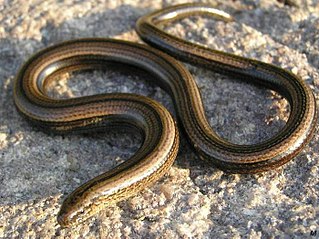
Amphisbaenia is a group of usually legless squamates, comprising over 200 extant species. Amphisbaenians are characterized by their long bodies, the reduction or loss of the limbs, and rudimentary eyes. As many species have a pink body and scales arranged in rings, they have a superficial resemblance to earthworms. While the genus Bipes retains forelimbs, all other genera are limbless. Although superficially similar to the snakes and blind lizards, recent phylogenetic studies suggest that they are most closely related to wall lizards of the family Lacertidae. Amphisbaenians are widely distributed, occurring in North America, Europe, Africa, South America, Western Asia and the Caribbean. They are not found east of the Caspian Sea. Most species are less than 6 inches (150 mm) long.

Anguidae refers to a large and diverse family of lizards native to the Northern Hemisphere. Common characteristics of this group include a reduced supratemporal arch, striations on the medial faces of tooth crowns, osteoderms, and a lateral fold in the skin of most taxa. The group includes the slowworms, glass lizards, and alligator lizards, among others. The family is divided into three subfamilies, and contains about 100 species in 10 genera.

Aprasia is a genus of lizards in the family Pygopodidae. The genus is endemic to Australia. The species in the genus Aprasia are worm-like, burrowing lizards. At least four of the species are oviparous.

The slow worm is a reptile native to western Eurasia. It is also called a deaf adder, a slowworm, a blindworm, or regionally, a long-cripple. These legless lizards are also sometimes called common slowworms. The "blind" in blindworm refers to the lizard's small eyes, similar to a blindsnake.

Live food is living animals used as food for other carnivorous or omnivorous animals kept in captivity; in other words, small preys fed alive to larger predators kept either in a zoo or as a pet.

The Iberian worm lizard, Mediterranean worm lizard, or European worm lizard is a species of reptile in the family Blanidae of the clade Amphisbaenia. The Iberian worm lizard is locally known as cobra-cega (Portuguese), culebrilla ciega (Spanish), and colobreta cega (Catalan), all meaning "blind snake". Recent studies into the mitochondrial and nuclear genomic data of 47 isolated B. cinereus populations show rather large sequence divergence between two apparent clades, leading some researchers to call for a division of the Iberian worm lizard into two species. While little is known of B. cinereus in comparison with some other reptile species, new insight is growing about this primitive, ancestral reptile.

Blanus is a genus of amphisbaenians found in the Mediterranean region of Europe and North Africa. Like other amphisbaenians, Blanus species are specialized for a subterranean existence, with long, slender bodies, reduced limbs, and rudimentary eyes. Their skulls are powerfully constructed, allowing them to push through soil to create a burrow. Their jaws are well-developed, with large, recurved teeth and a pair of canine-like teeth in the upper jaw.

The East African armadillo lizard, also commonly known as the dwarf sungazer or the tropical girdled lizard, is a species of arboreal or rupicolous (rock-dwelling) lizard endemic to East Africa.

Diploglossidae is a family of anguimorph lizards native to the Americas. Members of the genera Celestus and Diploglossus are known as galliwasps. They were formerly considered a subfamily of Anguidae, but genetic evidence has shown them to be less closely related to other members of Anguidae than Anniellidae is.

Worms are many different distantly related bilateral animals that typically have a long cylindrical tube-like body, no limbs, and no eyes.

Amphisbaena is a genus in the family Amphisbaenidae, commonly known as worm lizards. Over 100 species are placed in this diverse genus.
Cynisca is a genus in the family Amphisbaenidae, commonly known as worm lizards. 20 species are placed in this genus.
Monopeltis is a genus of amphisbaenians in the family Amphisbaenidae. Species in the genus are commonly known as worm lizards, even though they are not lizards. The genus is endemic to southern Africa. 19 species are placed in this genus.
Ophiodes enso is a species of lizard of the Diploglossidae family. It is found in Brazil.
Ophiodes fragilis, the fragile worm lizard, is a species of lizard of the Diploglossidae family. It is found in Argentina, Paraguay, and Brazil.

Ophiodes intermedius is a species of lizard of the Diploglossidae family. It is found in Argentina, Paraguay, Uruguay, and Bolivia.
Ophiodes luciae, Lucy’s worm lizard, is a species of lizard of the Diploglossidae family. It is found in Paraguay.
Ophiodes striatus, the striped worm lizard, is a species of lizard of the Diploglossidae family. It is found in Brazil, Paraguay, and Uruguay.

Ophiodes vertebralis, the jointed worm lizard, is a species of lizard of the Diploglossidae family. It is found in Brazil, Argentina, and Uruguay.











